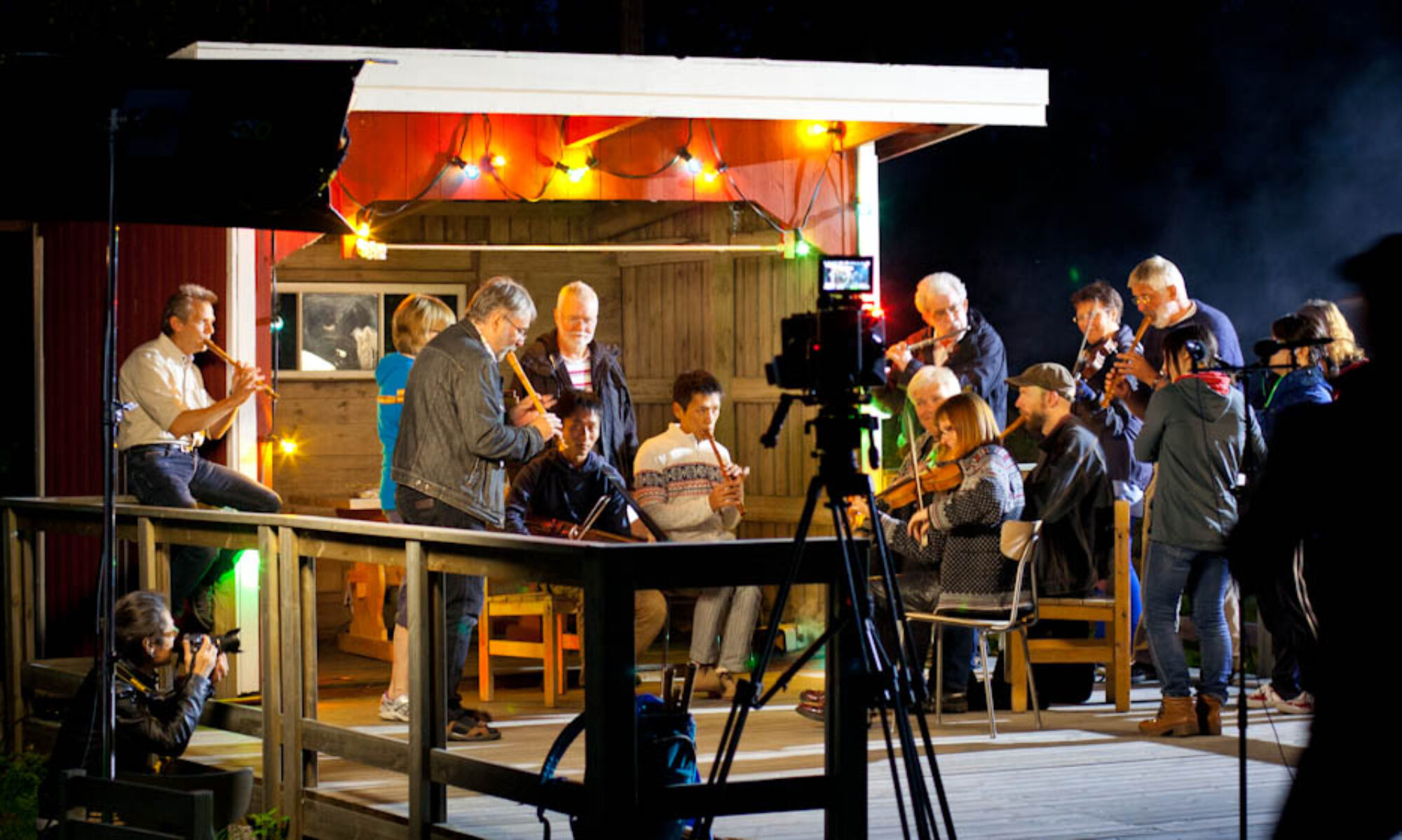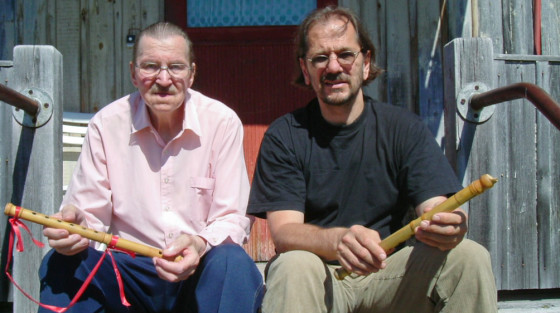This is how Dan Lundberg described the revival of the härjedalspipa in the opening section of the music collection Ol’ Jansas låtbok, published by Emma Grut and Svenskt Visarkiv in 2005.
Olof Jönsson – Ol’Jansa – from the village of Överberg in the county of Härjedalen (northern Sweden, bordering Norway) would hardly in his wildest dreams imagine how his tunes and his flute-playing would be spread and used. Olof Jönsson, like many other traditional flute-players, was not a stage musician – he used his instrument mainly for his own amusement.
He was recorded on three occasions between 1935 and 1951 – by Landsmålsarkivet and Radiotjänst (Swedish dialect archive and the Swedish Radio). Olof Jönsson and his playing were clearly regarded as an exciting – perhaps even exotic – phenomenon in Swedish traditional music, a remnant of bygone days which felt more and more distant in modern-day Sweden.

Basen, Jonas Jönsson’s farm in Överberg (photo: Gunnar Stenmark, 2015)
Flutes are among our oldest, most-widespread tone instruments. Olof Jönsson’s flutes were made by his brother, Jonas – bored and turned on a simple treadle lathe in the workshop of their farm, Basen, in Överberg. The Swedish flute models played by Olof Jönsson and other musicians in Härjedalen belong to a family of six-hole flutes to be found throughout most of Europe. It is fascinating that Härjedalen’s spelpipa, Britain’s tin whistle, Russia’s svirel, Poland’s fujarka, Romania’s fluier, Serbia’s frula and a number of other types of flute are on the whole identically-constructed instruments. (1) All of these are similar to the recorder, with straight cylindrical bores and six holes on the upper side. The straight bore means that they have a strong lower register compared to other recorder-like flutes, and they are suitable for tunes with a range of up to one-and-a-half octaves. The six holes enable the playing of normal seven-note scales without exceptionally-complicated fingering or overblowing. The appearance of a number of Swedish and Norwegian traditional flutes suggests influence from professionally-made recorders: during the 18th century German recorders were imported, and many flautists and flute-makers must have been inspired by these finely-turned instruments.
In Sweden the flutes had different regional names, usually a combination of dialect words for ”play” and for ”flute” – ”play-flute” – for example spilåpipa (Älvdalen, Dalarna) or spälapipe (Överberg, Härjedalen). Other names originate from the context in which the instrument was played, such as vallpipa (pastoral flute) or låtpipa (tune flute). Flutes could also be named on the basis of their appearance or material – långpipa (long flute), träpipa (wood flute), björkpipa (birch flute) or granpipa (fir flute).
The modern terms evertbergspipa, härjedalspipa, hälsingepipa and offerdalspipa are a completely different type of name which is common in the context of museums and archives. This kind of name refers to the provenance of the instrument and has not normally been used by the local musicians.
Six-hole flutes are of course not the only flutes used in traditional music. In various parts of Sweden, as in the rest of Europe, musicians have used various kinds of flute: differing numbers of holes, differing constructions. The Älvdalen spilåpipa with its eight holes, seven-hole flutes from the vicinity of Leksand and sallow flutes (which have no finger holes) are examples of this variation.
Flutes are relatively easy to make and play – and also very portable, which surely goes a long way towards explaining their spread. Traditionally, the flute has been the instrument of the shepherd. This has also been the case in Sweden. In the fäbod (summer pasture) culture, flutes were – together with horns and trumpets – common instruments. Yet flutes were – unlike horns and trumpets – not work instruments, rather being used to pass the time in the evenings and breaks.
There are nigh-on 40 traditional flutes at the Swedish Museum of Performing Arts in Stockholm. Most are from Dalarna, not least because collectors tended to concentrate on that county. There are, however, two flutes there from Hälsingland and one from Lillhärdal in southern Härjedalen.
Not many Swedish flute models have survived in the tradition, but just a hundred years ago many local variants were played in different areas. It is not easy to explain why certain models survived longer than others. In many cases, an element of chance might well have played a part: some flutes were ”lucky”, ending up in the hands of an interested collector, a folk music enthusiast or with a museum; others fell by the wayside.
Then something happened in the 1980’s: in the aftermath of the folk music vogue, many folk musicians started to look for new means of expression. One way was to use instruments from other traditional genres, another was to rediscover older instruments. The instrument maker Leif Eriksson, the musician Per Gudmundson and Gunnar Ternhag at Dalarna’s Museum developed a Swedish bagpipe based on older models. The last Swedish bagpipe had been played in the tradition by Gudmunds Nils Larsson of Dala-Järna in the 1940’s. The bowed-harp, various hurdy-gurdies and older types of keyed fiddle had already returned in the 1970’s. The Swedish folk musician Magnus Bäckström published ”Jag blåste i min pipa” (I Blew My Flute) – a booklet with tunes for the ”spilåpipa” – in 1980. This booklet was, moreover, a plea for flute-playing and an attempt to raise its status: ”I hope that the stamp of curio will disappear, and that the world of music in Sweden will discover and utilise the many musical and pedagogical advantages of the flute.” (2)
The ”Härjedalspipa” was reborn as part of the project ”Musik i Härjedalens skogar förr och nu” (Music in the Forests of Härjedalen, Past and Present). This originated when the musicians Mats Berglund and Ale Möller joined forces with the instrument maker Oskar Olofsson of Lillhärdal. Mats wanted to find a new Swedish flute – different to the better-known models from Dalarna – and Ale had a broad knowledge of traditional flute-playing. The local musicians Greger Brändström and Lasse Sörlin were brought in to enrich the repertoire. Two sources were used for the repertoire: fiddle tunes from Härjedalen and the flute tunes played by Olof Jönsson on documentary recordings. The results may be heard on the CD ”Härjedalspipan”, a re-issue of the LP from 1990. (3) The work on this project was diligently pursued. Meticulous measures were made of the range of the flute and its playing possibilities. Sound recordings and films were studied. Ale Möller evaluated Olof Jönsson’s playing:
Olof Jönsson’s ornamentation is richly-developed, particularly with regard to fore-notes and trills.
Especially impressive is his ability to adapt the speed of his trills so that they attain a specific relationship to the basic pulse of the tune, thus becoming not merely a decorative aspect but an accentuation of the rhythmic expression of the tune. Generally, both trills and fore-notes are slower than one is accustomed to – in fiddling, for example. (4)
The ”Härjedalspipan” LP was a success – in folk-music terms, at least – and meant that this variety of flute was reborn in a ”package” with a repertoire and playing technique featuring skilled musicians. Ale Möller tells that the name ”Härjedalspipan” was chosen strategically in order to strengthen the regional ties and make local institutions more willing to support the project. In addition, Oskar Olofsson had started making flutes. Oskar, who had himself made fiddles, had been charged with the task of finding a suitable flute-maker in Härjedalen. This was easier said than done, and he ended up attempting to turn a flute in accordance with Ale Möller’s measurements. The result exceeded expectations, and Oskar managed to make more than 200 flutes before concluding that he was too old to work at the lathe. Oskar Olofsson conveyed the art of flute-making to Gunnar Stenmark of Ås in the neighbouring county of Jämtland, and Gunnar had made and sold around 350 Härjedalen flutes by 2005. By that date – counting also flutes from other small-scale makers – around 600 flutes had been made which in one way or another originated from Olof Jönsson’s ”spelpipa”.(5)
Oskar Olofsson and Gunnar Stenmark at Oskar’s home in Lillhärdal, July 2004. Photo: Elisabet Grönlund.
Life has, in other words, been blown into the ”Härjedalspipa”. Today, a number of courses take place each year – and will hopefully find this book of use. Olof Jönsson and his tunes have become the needle’s eye for a tradition. The tradition has survived thanks to his tunes and his instrument. Questions arise, as in all revival movements. Does the flute sound the way it did when Olof Jönsson played? Was Olof Jönsson representative of flute-playing in Härjedalen? A common criticism in connection with a revival is that it is impossible to attain ”authenticity”. Yes – it is hard to hear how the music sounds on scratchy recordings, and we are definitely unable to know how the music was regarded in its original context. The making of instruments changes with new and more effective tools, musical role models are more skilled, and first and foremost: new media and music habits have changed our musical experiences. Modern-day flute-making involves adapting to the demands of our times with regard to more exact tuning and the possibility of playing together.
Yet it is the interplay of change and continuity that characterises a living tradition. In that sense, one might say that the ”Härjedalspipa” is both new and old – as it must be if the tradition is to function. The attempt at resuscitation has succeeded – the flute from Överberg in Härjedalen is alive and in good health.
Stockholm, February 2005
Dan Lundberg
Director, Svenskt visarkiv (The Centre for Swedish Folk Music and Jazz Research)

